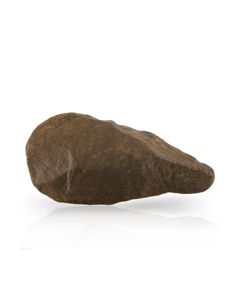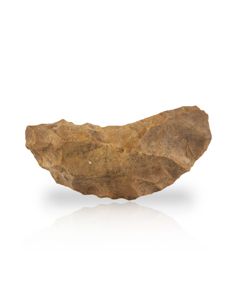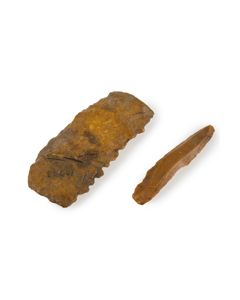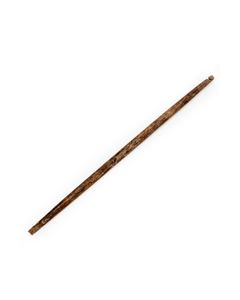Tools - Egypt and North Africa - Sold antiquities
Archive of sold antiquities
All artefacts sold in our gallery are fully documented in our online archive and database. Being a specialist ancient art dealer, preserving also the more recent history of each and every piece sold in our shop is at our heart. That is particularly useful for artefacts that changed owners in the meantime. Information that may have been lost in the process can be easily restored from our archives. Please do not hesitate to contact us if you need further information about ancient items that have been sold in our gallery. We can help you with reconstructing the history of ownership for those items. All information about our customers will be kept confidential, of course.-
 Large paleolithic hand axe
Large paleolithic hand axePrehistoric stone tool made of wonderfully banded stone. It was the universal tool of the older Stone age and could be used as a borer or a cutter. From a Swiss museum collection. Found in Morocco, North Africa.
Price: on request Paleolithic hand axe
Paleolithic hand axePrehistoric stone tool. It was the universal tool of the older Stone age and could be used as a borer or a cutter. From a Swiss museum collection. Found in Algeria, North Africa.
Price: on request Large Paleolithic hand axe
Large Paleolithic hand axePrehistoric stone tool. It was the universal tool of the older Stone age and could be used as a borer or a cutter. From a Swiss museum collection. Found in Foggaret Ezzaouia, Algeria, North Africa.
Price: on request Paleolithic hand axe
Paleolithic hand axePrehistoric stone tool. It was the universal tool of the older Stone age and could be used as a borer or a cutter. From a Swiss museum collection. Found in the Algerian Sahara desert.
Price: on request Paleolithic hand axe
Paleolithic hand axePrehistoric stone tool. It was the universal tool of the older Stone age and could be used as a borer or a cutter. From a Swiss museum collection. Found in the Algerian Sahara desert.
Price: on request Paleolithic hand axe
Paleolithic hand axePrehistoric stone tool. It was the universal tool of the older Stone age and could be used as a borer or a cutter. From a Swiss museum collection. Found in Morocco, North Africa.
Price: on request Paleolithic hand axe
Paleolithic hand axePrehistoric stone tool. It was the universal tool of the older Stone age and could be used as a borer or a cutter. From a Swiss museum collection. Found in Erg Mehedjibat, Algeria, North Africa.
Price: on request Large Paleolithic hand axe
Large Paleolithic hand axePrehistoric stone tool. It was the universal tool of the older Stone age and could be used as a borer or a cutter. From a Swiss museum collection. Found in Erg Mehedjibat, Algeria, North Africa.
Price: on request Huge Paleolithic hand axe
Huge Paleolithic hand axePrehistoric stone tool. It was the universal tool of the older Stone age and could be used as a borer or a cutter. From a Swiss museum collection. Found in Morocco, North Africa.
Price: on request Paleolithic hand axe
Paleolithic hand axePrehistoric stone tool. It was the universal tool of the older Stone age and could be used as a borer or a cutter. From a Swiss museum collection. Found in Morocco, North Africa.
Price: on request Large prehistoric hand axe
Large prehistoric hand axeMassive Paleolithic stone tool. It was the universal tool of the older Stone age and could be used as a borer or a cutter. From a Swiss museum collection. Found in Algeria, North Africa.
Price: on request Paleolithic hand axe or borer
Paleolithic hand axe or borerPrehistoric stone tool. It was the universal tool of the older Stone age and could be used as a borer or chisel. From a Swiss museum collection. Found in the Algerian Sahara desert.
Price: on request Stone Age bow scraper from Egypt
Stone Age bow scraper from EgyptThe Paleolithic tool is of beautiful shape and color. Thebes has been handed down as the place of origin. From an old museum collection.
Price: on request Paleolithic hand axe
Paleolithic hand axePrehistoric stone tool. It was the universal tool of the older Stone age and could be used as a borer or a cutter. From a Swiss museum collection. Found in Erg Mehedjibat, Algeria, North Africa.
Price: on request Large Paleolithic hand axe
Large Paleolithic hand axePrehistoric stone tool. It was the universal tool of the older Stone age and could be used as a borer or a cutter. From a Swiss museum collection. Found in Foggaret Ezzaouia, Algeria, North Africa.
Price: on request Flint blade and stone mould
Flint blade and stone mouldInteresting group of two artefacts. A Neolithic flint blade from Egypt and a Bronze Age mould for casting or hammering metal.
Price: on request Paleolithic hand axe
Paleolithic hand axePrehistoric stone tool. It was the universal tool of the older Stone age and could be used as a borer or a cutter. From a Swiss museum collection. Found in Algeria, North Africa.
Price: on request Stone Age bow scraper from Egypt
Stone Age bow scraper from EgyptThe Paleolithic tool is shaped like a sickle. Thebes has been handed down as the place of origin. From a 100 year old museum collection.
Price: on request Neolithic stone tool from Egypt
Neolithic stone tool from EgyptThe Stone Age weapon's point or knife blade is well crafted, with finely serrated edge. From a 100 year old museum collection.
Price: on request Paleolithic hand axe
Paleolithic hand axePrehistoric stone tool. It was the universal tool of the older Stone age and could be used as a borer or a cutter. From a Swiss museum collection. Found in Algeria, North Africa.
Price: on request Paleolithic hand axe
Paleolithic hand axeSmall prehistoric stone tool. It was the universal tool of the older Stone age and could be used as a borer or a cutter. From a 100 year old museum collection.
Price: on request Paleolithic hand axe
Paleolithic hand axePrehistoric stone tool. It was the universal tool of the older Stone age and could be used as a borer or a cutter. From a Swiss museum collection. Found in Ouarzazate, Morocco.
Price: on request Paleolithic hand axe
Paleolithic hand axeSmall prehistoric stone tool. It was the universal tool of the older Stone age and could be used as a borer or a cutter. From a 100 year old museum collection.
Price: on request Two Neolithic stone tools from Egypt
Two Neolithic stone tools from EgyptThe Stone Age saw and the slender blade are finely worked. From a 100 year old museum collection.
Price: on request Stone Age bow scraper from Egypt
Stone Age bow scraper from EgyptThe Paleolithic tool is of beautiful shape and color. Thebes has been handed down as the place of origin. Including old museum display.
Price: on request Paleolithic hand axe
Paleolithic hand axeSmall prehistoric stone tool. It was the universal tool of the older Stone age and could be used as a borer or a cutter. From a 100 year old museum collection.
Price: on request Neolithic stone tool from Egypt
Neolithic stone tool from EgyptThe Stone Age weapon's point or knife blade is well crafted, with finely serrated edge. From a 100 year old museum collection.
Price: on request Roman-Egyptian spindle whorl from mosaic glass
Roman-Egyptian spindle whorl from mosaic glassCone-shaped spindle whorl from the time of Roman rule over Egypt. The beautifully made mosaic glass weight is certainly a showpiece of every collection.
Price: on request Egyptian spindle shaft made of wood
Egyptian spindle shaft made of woodExceptionally rare main piece of a hand spindle. A find from Thebes in Upper Egypt. From the reign of pharao Senusret II, around 1840 BC.
Price: on request Paleolithic hand axe of Homo Erectus
Paleolithic hand axe of Homo ErectusBig hand axe from Niger. Made during the Old Stone Age, around 200,000 years ago. The universal stone age tool could be use as a borer or cutting tool.
Price: on request Egyptian palette of the Middle Kingdom
Egyptian palette of the Middle KingdomWorkpiece of an artisan for grinding materials. A very similar grinding palette was found in Abydos. From the inventory of the Falmouth Museum.
Price: on request Paläolithische Handaxt des Homo Erectus
Paläolithische Handaxt des Homo ErectusAltsteinzeit, um 200.000 v. Chr. Deutliche Spuren grober Werkzeugbearbeitung durch Homo Erectus. Schweres Objekt mit dunkler Patina.
Price: on request Paläolithische Handaxt des Homo Erectus
Paläolithische Handaxt des Homo ErectusAltsteinzeit, um 200.000 v. Chr. Deutliche Spuren grober Werkzeugbearbeitung durch Homo Erectus. Schweres Objekt mit dunkler Patina.
Price: on request Paläolithische Handaxt des Homo Erectus
Paläolithische Handaxt des Homo ErectusAltsteinzeit, um 200.000 v. Chr. Deutliche Spuren grober Werkzeugbearbeitung durch Homo Erectus. Schweres Objekt mit dunkler Patina.
Price: on request Nordafrikanisches Beil aus Felsgestein
Nordafrikanisches Beil aus FelsgesteinPräzise gearbeitete polierte Flächen. Sehr schöner grau-grüner Stein. Neolithikum, ca. 6000 v. Chr. bis 2500 v. Chr.
Price: on request Antiker Spinnwirtel aus Ägypten
Antiker Spinnwirtel aus ÄgyptenHellenistischer bis römsicher Spinnwirtel aus Naturstein. Flacher Körper mit kreisförmigem Querschnitt. 4 Jh. v. Chr. bis 4. Jh. n. Chr.
Price: on request

